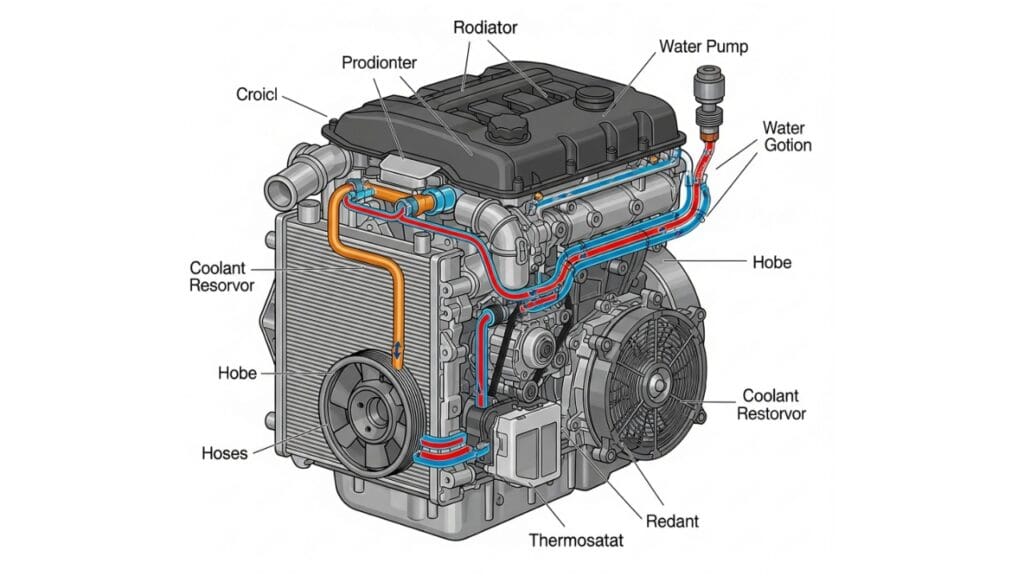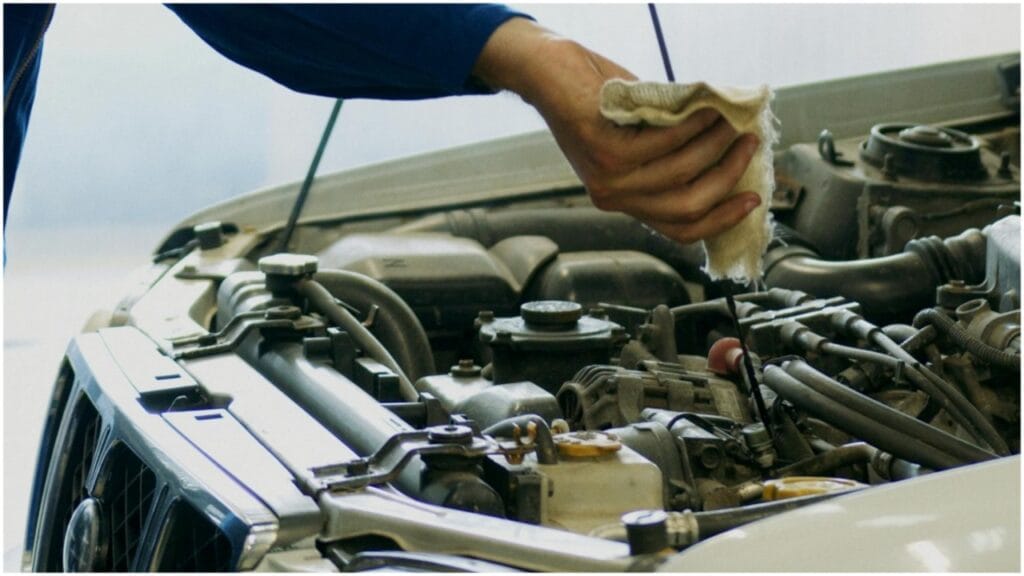Your car’s engine generates intense heat. Keeping it cool is vital, and that’s where coolant comes in. Many wonder: “Does coolant level rise when the engine is hot?” The answer is yes. This normal expansion is crucial for your car’s health. We’ll explore why this happens and what to look for.
what is engine coolant?
Engine coolant, also known as antifreeze, is a specialized fluid. Its primary function is to absorb excess heat from a car’s engine, preventing it from overheating. In addition to cooling, it also works by raising the boiling point of water and lowering its freezing point.
This mixture of water, glycol, and additives protects against corrosion and lubricates components, helping your engine run smoothly in any situation.
what does engine coolant do?
Engine coolant works as your engine’s climate control. It absorbs extreme heat from the engine and carries it to the radiator. Here, heat dissipates into the air. This cycle prevents overheating and freezing, maintaining optimal engine temperature for efficient performance and longevity.
Is coolant necessary for car?
Coolant is essential for your car. Without it, your engine would quickly overheat, leading to severe, often irreversible damage. It’s not just about cooling; coolant also prevents freezing in winter and protects vital engine parts from corrosion. It’s a non-negotiable fluid for your vehicle’s health and longevity.
Understanding Coolant Reservoir Behavior
The coolant reservoir, or overflow tank, is a plastic container that is connected to your car’s cooling system. Its main function is to hold excess coolant. When the engine overheats, the coolant expands and flows into this reservoir.
When the engine cools down, the coolant contracts and returns to the system, keeping the level balanced. Here’s some basic information to help you understand it better.
Thermal Expansion
Thermal expansion is a fundamental property of matter. Simply put, most substances expand when heated and contract when cooled. This happens because increased heat energy makes molecules move faster and spread out. In your car’s cooling system, the coolant experiences this effect, increasing in volume as the engine gets hot.
Expansion Tank
The expansion tank, often called the coolant reservoir, is a vital part of your car’s cooling system. It safely collects coolant as it expands from heat. When the engine cools, the coolant contracts, and the tank feeds it back. This ensures the system always has the right amount of fluid.
Normal Fluctuations
It’s completely normal for your coolant level to change slightly. As your engine heats up, the coolant expands, and its level in the reservoir rises. When the engine cools down, the coolant contracts, and the level drops. These small shifts simply mean your cooling system is working correctly.
Pressure
Pressure in your vehicle’s cooling system is extremely important. The radiator cap can and does maintain this pressure, significantly increasing the boiling point of the coolant. Proper pressure ensures effective cooling and prevents engine damage.
How Coolant Works in a Hot Engine?
When the engine overheats, the coolant actively circulates and absorbs the intense heat. It then flows to the radiator, where the heat is easily dissipated into the air.
System pressure prevents boiling by raising the boiling point of the coolant.The expansion tank handles volume changes. This continuous process precisely maintains optimal engine temperature.
Engine cooling system diagram

A hot engine’s coolant is circulated by a water pump. And a thermostat controls the flow to the radiator, where heat is dissipated, with the help of a fan.
The radiator cap maintains pressure, preventing the water from boiling. An expansion tank controls the amount of coolant. This system keeps the engine constantly cool.
Coolant properties
Coolant has important properties. It efficiently transfers heat from the engine. It is able to and works to prevent freezing in winter and boiling in summer. Importantly, it contains corrosion inhibitors to protect metal components. These properties ensure stable engine temperatures and longevity.
High Thermal Conductivity
High thermal conductivity means a material plays a key role in transferring heat very quickly. For engine coolant, this characteristic is extremely important. Coolant with high thermal conductivity can quickly remove heat from hot engine components. This efficient heat transfer helps prevent overheating, ensuring that your engine is operating at its optimum temperature.
High Boiling Point
A high boiling point is very important for engine coolant. This means that the coolant can get very hot before it turns into vapor. This can allow your engine to operate at high temperatures without the liquid boiling, which can cause the engine to overheat and even cause serious engine damage. This is very important for efficient cooling.
Low Freezing Point
The engine coolant has a low freezing point. This keeps it liquid in cold weather. It stops the fluid from freezing. Frozen coolant expands with force. This can badly damage the engine block. It can also harm other vital parts. This is crucial for engine safety.
Corrosion Resistance
Coolant contains special additives to prevent corrosion. These can protect internal engine metals like aluminum and iron from rust and chemical corrosion. Without it, important components like the radiator and water pump will wear out quickly. This is essential for the longevity of the engine.
Low Viscosity
Low viscosity means the coolant is thinner and can flow easily. This is essential for fast circulation throughout the engine. Fast flow ensures efficient heat transfer, allowing the coolant to reach all the hot spots quickly. This is important for effective cooling.
Chemical Inertness
Chemical inertness means a substance does not react with other materials. It prevents the coolant from breaking down or corroding the metal and rubber components of your engine. This stability ensures the cooling system functions reliably.
Reduced Foaming
Reduced foaming means the coolant resists creating air bubbles while circulating. Foam reduces the coolant’s ability to efficiently transfer heat. It can also cause cavitation damage to the water pump. Coolant additives prevent this, ensuring stable and effective engine cooling performance.
Material Compatibility
Material compatibility means that the coolant will not damage any material. This includes various metals such as aluminum and iron, as well as rubber pipes and plastic parts. A compatible coolant prevents corrosion, swelling, or erosion. It is able to ensure that the cooling system is intact and leak-free.
Environmental Safety
Engine coolant can cause serious damage if not handled properly. Improper disposal can contaminate water and soil, harming animals and plants. Therefore, it is important to use environmentally safe alternatives such as propylene glycol-based coolants. Always dispose of used coolant responsibly at designated facilities.
Maintenance Tips

You can check the coolant level regularly when the engine is cold. Make sure it is between the “minimum” and “maximum” marks. Always use the correct type of coolant for your vehicle. Watch for any signs of leaks or discoloration. Proper maintenance prevents costly engine damage.
Regular Checks
Regularly checking your coolant level is simple but crucial. Always do this when the engine is cold. Look at the coolant reservoir; the fluid should be between the “MIN” and “MAX” lines. This quick habit helps you spot potential issues early, preventing serious engine trouble.
Temperature Awareness
Pay attention to your car’s temperature gauge. Know its normal operating range. If the needle rises to the red mark, and if you see steam, your engine is overheating. Pull the car over safely and turn it off immediately. Early warning prevents serious damage.
Flush System
Flushing the cooling system means completely draining old, contaminated coolant. Then, fresh coolant is added. This process removes rust, scale, and harmful deposits. It also replenishes vital protective additives. Regular flushing improves cooling efficiency and extends the lifespan of your engine’s cooling components.
Too much pressure in coolant reservoir
Too much pressure in your coolant reservoir is a serious warning sign. It often indicates a problem like a failing radiator cap, a clogged hose, or a more severe issue such as a blown head gasket. Excessive pressure can damage hoses, the radiator, or even the engine itself. Get it checked promptly.
How does pressure affect coolant levels?
Pressure significantly affects coolant levels. It raises the coolant’s boiling point, preventing it from boiling at high engine temperatures. This controlled pressure also pushes expanded coolant into the reservoir. It ensures efficient heat transfer and keeps the system full.
FAQ’s
Why is my car’s coolant low when it’s hot?
If your car’s coolant level is low when the engine is hot, despite normal expansion, it indicates a problem. The most common cause is a leak somewhere in the cooling system. This can be caused by a problem with a hose, radiator, or water pump, and can be caused by:
Another cause is air trapped in the system. More seriously, a blown head gasket can push exhaust gases into the coolant. Always check the coolant level quickly on a low heat. This prevents serious engine damage.
Why does my car lose coolant without a leak?
If your coolant level is low, but there are no leaks, the problem is likely internal. Often, a blown head gasket is to blame. This causes coolant to burn in the engine’s combustion chamber or mix with the oil. Tiny air pockets trapped in the cooling system can also escape over time, displacing coolant.
Sometimes, a faulty radiator cap fails to hold proper pressure, leading to subtle evaporation. Always investigate unexplained coolant loss quickly; it signals hidden engine problems.
Conclusion
We’ve explored the car’s cooling system in detail. We covered how the expansion tank handles normal coolant fluctuations and the importance of pressure. Coolant’s key properties, like thermal conductivity, high boiling point, and low freezing point, are vital.
Remember to check levels regularly, be aware of temperature, and flush the system. Address issues like high pressure or unexplained coolant loss promptly for engine health and environmental safety.

